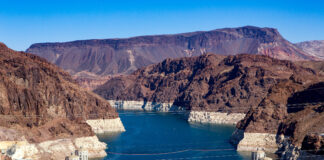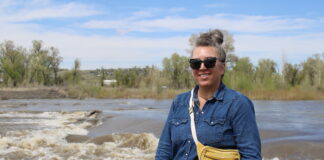
A version of this post originally appeared on Snow News on February 1, 2024.
The term “atmospheric river” (AR) has become common in weather stories and media coverage, but the name for these age-old events is a relative newcomer in meteorological glossaries.
Coined by scientists in the 1990s, the term’s popularity has soared in recent years as researchers, forecasters, journalists, and others have publicized the outsized role of atmospheric rivers in producing rain, snow, wind, and severe weather in the American West (and other places).
The recent atmospheric rivers that struck California illustrate why they can be both harmful and helpful. The storms not only caused deadly flooding but also gave the state’s meager snowpack a major boost. The map below shows the total liquid precipitation from February 1 to February 8.

Here’s a quick primer on ARs, why they matter, and what the future might hold for ARs as the climate warms.
What are atmospheric rivers?
These plumes of moisture are sometimes likened to “rivers in the sky” because they transport so much water vapor from the tropics toward higher latitudes. In data visualizations, like the one below, they can resemble a fire hose dousing the West Coast.

An AR is “a long, narrow, and transient corridor of strong horizontal water vapor transport that is typically associated with a low-level jet stream ahead of the cold front of an extratropical cyclone,” according to the American Meteorological Society’s Glossary of Meteorology.
“Atmospheric rivers are the largest ‘rivers’ of fresh water on Earth, transporting on average more than double the flow of the Amazon River.”
— American Meteorological Society’s Glossary of Meteorology
When ARs are forced upward by mountains or other forces, the water vapor cools, condenses, and precipitates, as shown in the graphic below. This NOAA figure says the amount of water vapor in a strong AR “is roughly equivalent to 7.5-15 times the average flow of water at the mouth of the Mississippi River.”

One type of AR has come to be known as the “Pineapple Express” because it taps moisture around Hawaii. The January 4 images below from the NASA Earth Observatory illustrate the connection: the top graphic depicts a measure of water vapor in the atmosphere and the bottom shows the view from a satellite.


ARs are critical for the West’s water and snowpack
Whether you compare ARs to the Amazon or the Mississippi, there’s no doubt they exude wetness, so they can have far-reaching effects on the West’s water resources, for better or worse.
On average, a few AR events contribute 30% to 50% of the annual precipitation in West Coast states, according to NOAA. A 2019 paper in Geophysical Research Letters concluded that AR storm days are responsible for about one-quarter of the snowpack in the Sierra Nevada and one-third of the snowpack in the Cascades of Oregon and Washington.
Even the Rocky Mountains benefit from ARs. A 2021 study in Geophysical Research Letters estimated that the snow produced by ARs accounts for 31% of the peak snow water equivalent in the Upper Colorado River Basin, where the majority of the river’s flow originates.
“Atmospheric river” is a relatively new term
ARs have been a big deal for eons—an average of about 11 are present on Earth at any time—but it wasn’t until the 21st century that the term entered into general circulation. The two graphics below, from NASA’s Jet Propulsion Laboratory and the Center for Western Weather and Water Extremes (CW3E) at the Scripps Institution of Oceanography, show the term’s growing use in news stories and peer-reviewed journal articles.


I took a peek at Google Ngram, which analyzes the text in books, and also found a sharp rise in the term’s use.

Some experts think the analogy to a terrestrial river is inappropriate, and some think the term is “duplicative of preexisting concepts, such as the warm conveyor belt,” according to this article in the Bulletin of the American Meteorological Society. Nevertheless, “atmospheric river” has jumped from peer-reviewed journals to water cooler conversations, not unlike “polar vortex,” “bomb cyclone,” and “heat dome.”
AR Scale rates severity with five categories
Just as hurricanes are classified by the Saffir-Simpson Hurricane Wind Scale, and tornadoes are categorized by the Enhanced Fujita Scale, ARs have their own rating scale.
The AR Scale is based on two factors: the duration of the event and its “maximum vertically integrated water vapor transport,” a measure of its water content and the speed at which it’s moving. As shown in the graphic below, there are five categories, with the bottom two described as primarily beneficial.

One way to summarize AR forecasts is shown below in a set of maps from CW3E, which describe conditions along three locations—coastal, foothills, and inland—from January 30 to February 6.

The forecast shows the southern Oregon coast is expected to reach Category 5, the most severe level, while other areas along the Pacific Ocean will reach Categories 3 and 4. Farther inland, conditions are expected to be less extreme, but at higher elevations, it’ll definitely be dumping.
ARs can end droughts but also cause major flooding
As noted by the AR Scale, these events can be both helpful and hazardous. On the positive side, ARs can be effective drought busters. A 2013 study in the Journal of Hydrometeorology concluded that about one-third of persistent droughts in California have been erased by AR storms, with 60% to 74% of droughts in the Pacific Northwest ending this way.
On the negative side of the ledger, ARs have been responsible for some of the worst floods on the West Coast, including nearly 90% of California’s flood damage. Even this week’s weather prompted some internet rumors that California would be subject to a “megaflood” of biblical proportions, according to this Los Angeles Times story, which noted that experts don’t think this is “the big one.”
One doomsday scenario, known as “ARkStorm,” is a deluge featuring wave after wave of ARs flooding large portions of California, displacing up to 10 million people, and causing a $1 trillion disaster. For more on this potential nightmare, check out “The Trillion-Gallon Question,” a 2023 story by Christopher Cox in The New York Times Magazine about the potential fragility of California’s water infrastructure.
And let’s not forget about the wind. “Atmospheric rivers are among the most damaging storm types in the middle latitudes, especially with regard to the hazardous wind they produce,” according to NASA. Researchers at the Jet Propulsion Laboratory found that ARs were to blame for up to half of the most destructive windstorms over the last two decades. In a 2017 study in Nature Geoscience, scientists concluded: “Landfalling atmospheric rivers are associated with about 40–75% of extreme wind and precipitation events over 40% of the world’s coastlines. Atmospheric rivers are associated with a doubling or more of the typical wind speed compared to all storm conditions, and a 50–100% increase in the wind and precipitation values for extreme events.”
Climate change will intensify ARs
As the planet continues warming, scientists expect ARs to strengthen. A warmer atmosphere can hold more water, so climate change is projected to boost the intensity of downpours. NASA scientists predict that by the end of the 21st century, climate change will make ARs about 25% wider and longer while increasing the global frequency of AR conditions, such as heavy rain and strong winds, by around 50%.
A 2021 paper focused on the West concluded that for every 1◦C of additional warming, annual average flood damages will rise by about $1 billion. Because warming is causing the snow level to rise, atmospheric rivers are more likely to drop rain, so they may not be as helpful to the snowpack, and when rain falls on snow, that can cause huge problems with flooding and debris flows.
The odds of an ARkStorm have doubled due to climate change and “runoff in the future extreme storm scenario is 200 to 400% greater than historical values in the Sierra Nevada because of increased precipitation rates and decreased snow fraction,” according to a 2022 paper in Science Advances.
For a great overview of climate change and ARs, see this recent Washington Post story from Kasha Patel. And check out this fascinating piece from Ian James at The Los Angeles Times to learn how scientists are using a hurricane-reconnaissance jet to study ARs.
Snow News is a free multimedia newsletter that covers the science of snow and the state of the snowpack.
The Water Desk’s mission is to increase the volume, depth and power of journalism connected to Western water issues. We’re an initiative of the Center for Environmental Journalism at the University of Colorado Boulder.





